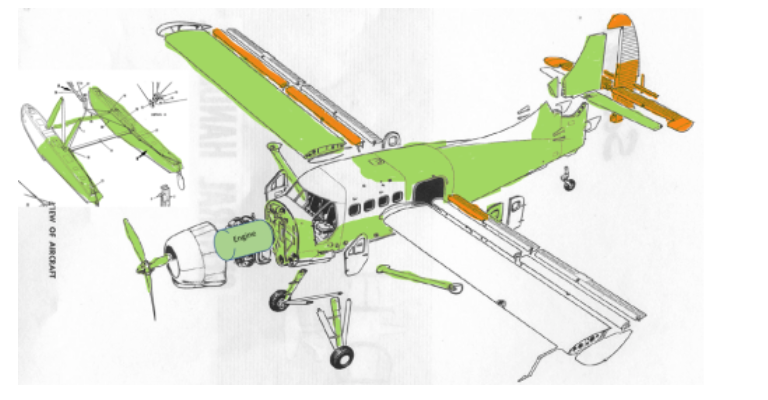img {
max-width: 100%;
width: 100%;
}

A vivid depiction of a de Havilland Canada Otter emerges, with the green sections prominently highlighting the parts of the plane that were recovered and the orange highlighting the flight controls that were also recovered. Courtesy of the NTSB.
Following the tragic crash on September 4, 2022, of a scheduled flight of a de Havilland Otter that plunged into Mutiny Bay in Washington, resulting in the demise of the pilot and nine passengers, the NTSB has issued a non-binding safety recommendation urging a check of the integrity of the crucial part, the elevator trim actuator that investigators believe might have been the cause behind the crash.
The plane, operated by Northwest Seaplanes, was on a flight from Friday Harbor in Washington to Renton, Washington, gracefully cruising low over the water when, based on flight data, its altitude and airspeed began to fluctuate. The plane gradually ascended a few hundred feet while its airspeed slowed to around 55 knots, and at that moment, the signals ceased. Witnesses described how the large single-engine aircraft suddenly lost control and spiraled into the water in a near-vertical descent from a height of over 1,000 feet above the surface. All 10 individuals aboard were tragically killed in the crash, and although only one body has been recovered thus far, the search was called off after several days due to the challenging circumstances.
The NTSB reached out to the US Navy to utilize a remotely operated sub to search for the wreckage, and indeed, the searchers were successful in locating the wreckage of the plane at the bottom of the bay, approximately 200 feet beneath the surface. They were able to recover around 85% of the wreckage, including vital tail components and the elevator trim actuator.
Investigators, who were endeavoring to uncover the reason why the plane slowed down and then commenced a descent out of control, seem to have found the probable culprit – a mechanical failure of the hardware that actuates the stabilizer trim and holds the stabilizer in its proper position. When functioning correctly, the actuator employs a cable to adjust the horizontal stabilizer’s angle of incidence. However, as discovered by the searchers, the actuator had come apart, a failure that, the NTSB suggests, would have led to the plane losing its control. In their correspondence, the Board stated, “The actuator is the sole means to maintain the horizontal stabilizer in its position, and the lock ring prevents the assembly from coming undone. During flight, if the clamp nut and the barrel unthread, it would result in a freely floating horizontal stabilizer, enabling it to rotate uncontrollably (with the trailing edge either up or down), potentially resulting in a loss of airplane control.”
In layman’s terms, at this point, the most likely explanation is that the failure of the actuator caused the stabilizer to lose its control, causing the nose to dip sharply downward. The pilot, presumably, would have attempted to correct this by raising the nose, which in turn would have lowered the plane’s airspeed, leading to an aerodynamic stall, a loss of control, and ultimately the crash into the bay.
The final report on the crash will have to wait, but in the meantime, the NTSB has tasked the current certificate holder to draft instructions for operators to inspect the integrity of the actuator.
A Fascinating Aviation Enigma: Why Did the de Havilland Comet Keep Crashing?